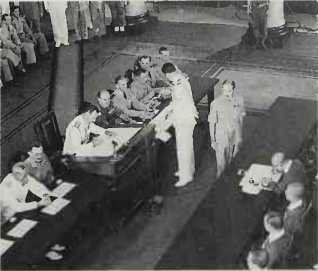
Mountbatten at Japanese surrender
Mountbatten Adm of the Fleet Earl (1900-1979). Br. Related to the Royal Family, the son of a previous First Sea Lord, a prominent socialite, Mountbatten was, and remains, a controversial figure. In 1939 he took command of 5th Destroyer Flotilla led by the Kelly. His leadership was outstanding, his tactical skill perhaps less so. In 1941, Kelly was sunk off Crete. Mountbatten was to have become captain of Illustrious, but Churchill instead appointed him as head of Combined Operations, where he contrived to produce a lively and inventive organization to which much credit for subsequent amphibious successes is due. In October 1943 he became Supreme Allied Commander in Southeast Asia where he had to cope not only with inter-service problems but also delicate problems of inter-allied relations. With the sudden surrender of the Japanese the problems became, if anything, worse. The complexities of dealing with Japanese and nationalist forces and the desperate need to reconstruct wrecked communications and industries - all were somehow dealt with. In 1947—1948 Mountbatten became the last Viceroy of India with the task of granting independence. He then returned to the Navy, and in 1955 became First Sea Lord (always an ambition after his father was driven from the post by antiGerman agitation and tiredness in 1914). He opposed the Suez Crisis (1956) and ensured that the Navy began to build guided-missile ships. In 1959 he became Chief of the Defence Staff, organizing the merging of the three service ministries into a greatly strengthened Ministry of Defence. He was killed in a bomb attack by Irish terrorists. DJL.
Mujib-ur-Rahman, Sheikh,
(1920-75). Formulated so-called Six Point Demand for virtual separation from Pakistan. Arrested, 1971, and sentenced to death but reprieved by rapid Indian victory. Prime Minister then President of Bangladesh. Assassinated August 1975.
Mujaheddin see Afghanistan,
SOVIET INTERVENTION IN (1979-89).
Mukden, Battle of (February 21-March 10 1905). In the last major land battle of the Russo-Japanese War, 300,000 Japanese (losses 84,000) under Oyama forced
310,000 Russians (losses 100,000) under Kuropatkin to retreat from entrenchments along a 47-mile (75 km) front, taking Mukden but failing to encircle and destroy the Russian force.
Mukden incident (1931) see sino-
JAPANESE WAR.
Mukti Bahini (or Mukti Fauj). The underground army which harassed the Pakistani troops in East Pakistan (Bangladesh) up to the Indian invasion, December 1971, in the India-Pakistan War. Said to number 100,000, its principal purpose was to provide legitimacy for Indian intervention.
Mulberry harbour. Code name for the two artificial harbours created for the D-Day invasion of Normandy, 1944. The Dieppe raid had shown how difficult it was to capture a port, and the Germans were known to be prepared for massive demolitions, so to keep the Allied army supplied, it was necessary to transport a harbour with the invasion fleet. Concrete breakwaters and pontoon jetties were towed over, floating roadways installed and old ships (“gooseberries”) sunk as breakwaters to provide sheltered anchorages. Bad weather soon after the invasion destroyed the harbour in the American sector off Omaha beach and supplies continued to be landed over the beaches there, but the one in the British sector at Arromanches was of use for several months. DJL.
Mullhouse, Battle of. On August 8, 1914. Gen Bonneau’s VII Corps, covering the extreme right flank of the French armies, entered Mul-house in Alsace. Within 24 hours the irresolute Bonneau lost the city to the German Seventh Army, forcing Joffre to reorganize the French right wing.
Multiple Independently Target-able Re-entry Vehicle (MIRV).
Most modern ballistic missiles have the facility to engage a number of different targets with individual warheads. They carry postboost vehicles (pbvs) which manoeuvre in space into a number of different trajectories into each of which they inject a warhead. Large missiles can carry large numbers of large warheads and enough fuel in the pbv to give a large “footprint” i. e. area in which a single missile’s warheads can fall. The Soviet SS-18 has been pictured in American sources distributing ten 500-750 kiloton MIRVS between the East Coast of the United States and the Rocky Mountains. Smaller missiles, like the American Poseidon slbm, can carry 10-14 warheads but these are small, only 50 kilotons, and targets have to be found in a “footprint” that is reportedly about 150 miles (240km) long and 90 miles (144km) wide, mirvs were first developed by the Americans in the late 1960s and first deployed in 1970-71 in the belief that the USSR would take a long time to catch up, but within a few years the Soviets had done so. Given the counter-force potential of mirvs, there is now a tendency on grounds of stability to revert to singlewarhead missiles. EJG.




 World History
World History









